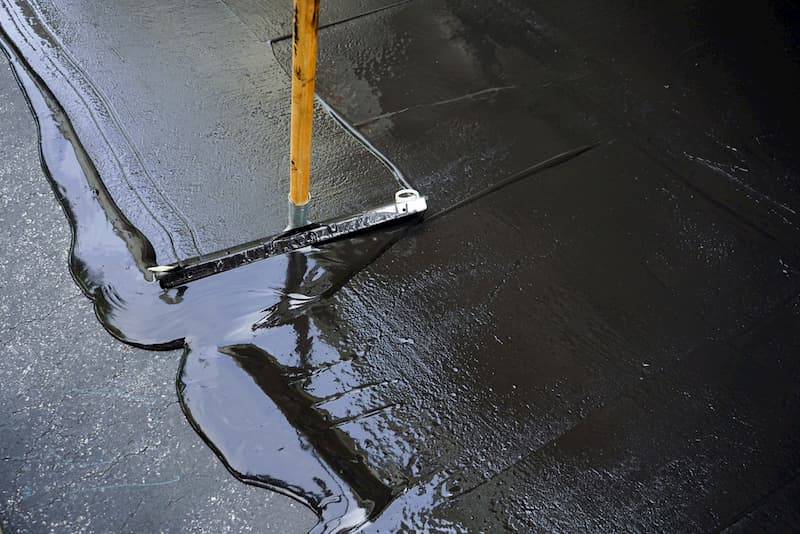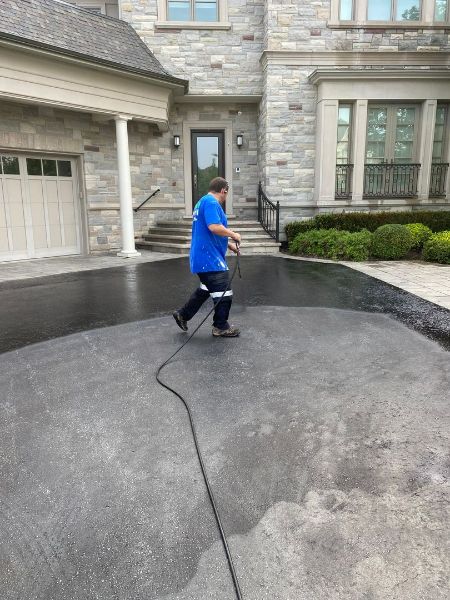Raise Commercial Charm: Hot Mix Asphalt Sealing for Angled Parking Lots
Raise Commercial Charm: Hot Mix Asphalt Sealing for Angled Parking Lots
Blog Article
Warm Mix Asphalt: A Sustainable Remedy for Pavement
Warm Mix Asphalt (HMA) has actually emerged as a leading sustainable option for pavement solutions, supplying a myriad of ingenious modern technologies and environmental benefits. As the need for eco-friendly building and construction practices grows, checking out the subtleties of HMA's sustainability can give beneficial understandings into the future of pavement options.
Environmental Benefits of Warm Mix Asphalt

Furthermore, Warm Mix Asphalt assists to reduce metropolitan warmth island impacts. Its dark shade absorbs sunlight, reducing the quantity of warm reflected back right into the atmosphere compared to lighter-colored sidewalks. This can decrease ambient temperatures in urban locations, reducing the demand for a/c and ultimately lowering power intake.
Additionally, Hot Mix Asphalt adds to boosted stormwater monitoring. Its porous nature allows water to charge and penetrate the pavement groundwater products, decreasing overflow and the threat of flooding. These ecological benefits make Warm Mix Asphalt a sustainable option for leading roadways and highways.
Energy Performance in HMA Manufacturing
Is power performance an essential consider the manufacturing of Hot Mix Asphalt (HMA)? Definitely. Power plays a considerable function in the production of HMA, impacting both expense and environmental sustainability. One key aspect of energy efficiency in HMA production is making use of warm mix asphalt (WMA) innovations (regrading). WMA enables for the mixing and placement of asphalt at lower temperature levels contrasted to typical hot mix asphalt, causing reduced power usage during manufacturing. This process not just lowers gas usage however additionally reduces greenhouse gas exhausts, making it an extra environmentally friendly option.
Additionally, improvements in plant innovations have actually caused even more energy-efficient HMA manufacturing procedures. Modern plants are made with attributes like recycled asphalt pavement (RAP) handling capacities, efficient burner systems, and boosted insulation, all adding to energy cost savings. By enhancing power usage in HMA manufacturing, the market can minimize its carbon footprint while keeping premium sidewalk products. Energy effectiveness is, consequently, a critical consideration in ensuring the sustainability of Warm Mix Asphalt manufacturing.
Recyclability of Warm Mix Asphalt
The recyclability of Warm Mix Asphalt (HMA) is a crucial facet of its sustainability and lasting environmental impact. HMA is one of one of the most recycled materials in the United States, with over 100 million bunches of redeemed asphalt pavement (RAP) being reused yearly in new pavement building. Reusing HMA supplies numerous environmental advantages, such as minimizing the need for virgin materials, reducing power usage during manufacturing, and decreasing the quantity of waste sent out to landfills.
The procedure of reusing HMA includes crushing the existing pavement, squashing it into smaller sized pieces, and blending it with new accumulation and asphalt binder to create a recycled mix. This recycled mix can frequently do along with or even far better than check out this site traditional HMA, while calling for less basic materials and generating reduced greenhouse gas emissions. By incorporating RAP right into brand-new sidewalk jobs, roadway companies can preserve natural deposits, reduce costs, and lessen the ecological footprint of roadway construction and upkeep tasks. In general, the recyclability of HMA plays a substantial role in advertising lasting practices within the sidewalk sector.

Long-Term Efficiency of HMA
Asphalt pavements show sturdiness and durability over a prolonged period, reflecting the long-term efficiency of Hot Mix Asphalt (HMA) The durability of HMA can be connected to its ability to hold up against hefty web traffic lots, extreme weather, and the impacts of aging. Research studies have shown that properly designed and effectively built HMA pavements can last for 20 years or even more with normal maintenance. The key to making the most of the long-term efficiency of HMA depends on using top quality products, complying with finest techniques in construction, and applying efficient maintenance approaches. Appropriate drainage, regular inspections, and timely repairs are crucial for protecting the structural honesty of HMA pavements over time. Furthermore, developments in HMA modern technology, such as using polymer-modified binders and cozy mix asphalt, have further enhanced the toughness and long life of HMA pavements. By prioritizing top quality building and upkeep practices, HMA proceeds to prove itself as a lasting and affordable remedy for resilient sidewalk facilities.

HMA: Durability and Sustainability
Demonstrating both resilience and sustainability, Hot Mix Asphalt (HMA) has become a keystone in the building and construction of durable sidewalk infrastructures - commercial parking lot paving. HMA's sturdiness originates from its ability to stand up to hefty tons, severe weather, and high web traffic volumes, making it a reliable selection for highways, highways, and flight terminal runways. The make-up of HMA, which pop over to this site normally includes aggregates, binder, and filler, plays a critical duty in improving its longevity and resistance to tear and use
Furthermore, HMA's sustainability lies in its recyclability and energy-efficient manufacturing process. The capacity to recycle reclaimed asphalt pavement (RAP) in brand-new HMA mixes reduces the need for virgin materials and decreases the environmental impact of sidewalk building and construction and upkeep. Additionally, the power effectiveness of creating HMA exists in its lower blending temperatures contrasted to other sidewalk materials, leading to minimized power consumption and greenhouse gas exhausts.
Conclusion
Finally, warm mix asphalt (HMA) supplies a lasting option for pavement with its eco-friendly qualities. HMA's recyclability, power efficiency in production, and long-lasting longevity make it an eco-friendly selection for roadway building and construction. By conserving natural deposits, reducing waste, and reducing greenhouse gas exhausts, HMA plays an important duty in promoting sustainability in facilities growth. Its capacity to alleviate city heat island impacts additionally emphasizes its significance in producing ecologically aware and resilient pavement systems.
HMA is one of the most recycled materials in the United States, with over 100 million heaps of redeemed asphalt sidewalk (RAP) being recycled each year in brand-new sidewalk construction.The process of recycling HMA includes grating the existing pavement, squashing it link right into smaller pieces, and mixing it with new aggregate and asphalt binder to create a recycled mix.Asphalt pavements show durability and resilience over an extended duration, mirroring the lasting efficiency of Warm Mix Asphalt (HMA) Furthermore, improvements in HMA innovation, such as the use of polymer-modified binders and warm mix asphalt, have further boosted the toughness and long life of HMA pavements. The ability to reuse reclaimed asphalt sidewalk (RAP) in brand-new HMA blends decreases the demand for virgin products and decreases the ecological effect of pavement building and construction and upkeep.
Report this page